Physical Address
304 North Cardinal St.
Dorchester Center, MA 02124
The concept of immediate and appropriate airway management spans all disciplines of medicine. Achieving, protecting, and maintaining the airway have been well recognized as the initial steps necessary in resuscitation of the critically ill or injured patient. The basic premise of the Advanced Trauma Life Support for Doctors Course (ATLS) is that all resuscitations should follow the mnemonic ABCDE: A irway, B reathing, C irculation, D isability, E xposure. This mnemonic, according to the ATLS, “defines the specific, ordered evaluations and interventions that should be followed in all injured patients.”
The optimal airway is one that an awake patient can maintain without assistance; the worst-case scenario is an airway that can be achieved only with surgical intervention—the dreaded “cannot intubate, cannot ventilate” situation. The success or failure to establish an adequate and protected airway is dependent on many factors. Techniques available to the clinician range from the simple to the complex. The concept of tracheal intubation is by no means a new one. In fact, the first documented report of tracheal intubation dates back to 1543 and actually refers to a tracheostomy. In his atlas On the Fabric of the Human Body , the Renaissance anatomist Andreas Vesalius observed, “Life may, in a manner of speaking, be restored. An opening must be attempted in the trunk of the trachea into which a reed or cane should be put; you will then blow into this so that the lung may rise again.”
From the clinician’s standpoint, the appropriate management of the airway can be the most stressful part of a patient’s initial care. This chapter will deal with the anatomic aspects of the head, neck, and respiratory system in which a clinician must be adept to successfully manage the airway. It will also address how these anatomic variations, in association with the clinical situation, will affect the clinician’s choice of airway management. The chapter will describe many of the available techniques used to obtain and maintain a secure airway.
Successful execution of any procedure demands a thorough understanding of the procedure: indications, technical requirements, and necessary equipment to complete the task. In addition, the operator must be cognizant of potential complications and their management. Obtaining an airway, whether by conventional or surgical means, is no different from any other procedure. The anatomy and normal functions of the structures that comprise the upper airway are complex. The surgeon must recognize the essential anatomic structures to effectively manage the airway.
The nose and mouth are the two natural external openings to the airway. The nasal cavity is separated by the nasal septum into two pyramids containing bone, cartilage, and sinus orifices. The roof of the nose is formed by the nasal and frontal bones, the ethmoid cribriform plate, and the body of the sphenoid bone. The floor is formed by the maxilla and palatine bones, and the medial wall by septal cartilage, the vomer, and the perpendicular plane of the ethmoid. Laterally, the wall contains a portion of the ethmoid bone, along with the superior, middle, and inferior turbinate bones. In addition, it contains the openings to the paranasal sinuses and the nasolacrimal duct ( Fig. 1 ). The nerve supply to the nasal cavities is from the olfactory and the trigeminal nerves (cranial nerves I and V, respectively). The blood supply is from the anterior and posterior branches of the ophthalmic artery, as well as branches of the maxillary and facial arteries.
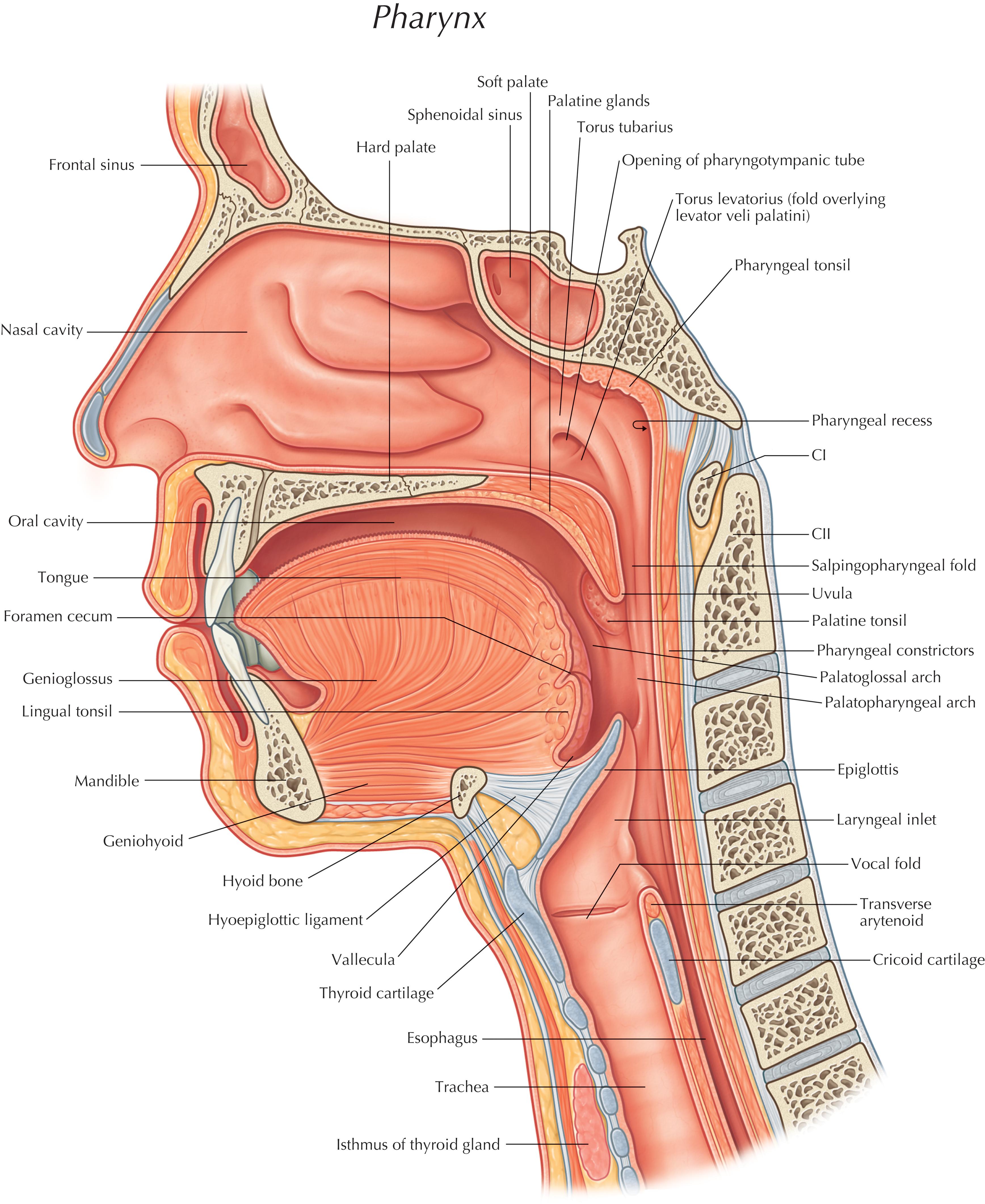
The mouth is defined by the lips and cheeks externally; the gingiva, teeth, and palate superiorly; and mucosa and tongue inferiorly. The palate forms the roof of the mouth and the floor of the nasal cavity. The hard palate forms the anterior four fifths of the palate and is a bony framework covered with a mucous membrane. The soft palate, composing the posterior one fifth of the palate, is a fibromuscular fold that moves posteriorly against the pharyngeal wall to close the oropharyngeal cavity when swallowing or speaking.
Although separated anteriorly by the palate, the mouth and nasal cavities join posteriorly at the end of the soft palate to form the pharynx. The pharynx is separated into the nasopharynx and the oropharynx. The pharynx extends to the inferior border of the cricoid cartilage anteriorly and the inferior border of the body of C6 posteriorly. The wall of the pharynx is composed of two layers of pharyngeal muscles: the external circular layer consists of the constrictor muscles and the internal longitudinal layer consists of muscles that elevate the larynx and pharynx during swallowing and speaking. The nasopharynx follows directly from the nasal cavity at the level of the soft palate and communicates with the nasal cavities through the nasal choanae and with the tympanic cavity through the eustachian tube. It contains the pharyngeal tonsils in its posterior wall. The oropharynx begins at the soft palate and continues to the tip of the epiglottis ( Fig. 2 ). It contains the palatine tonsils, important landmarks in the Mallampati airway classification.
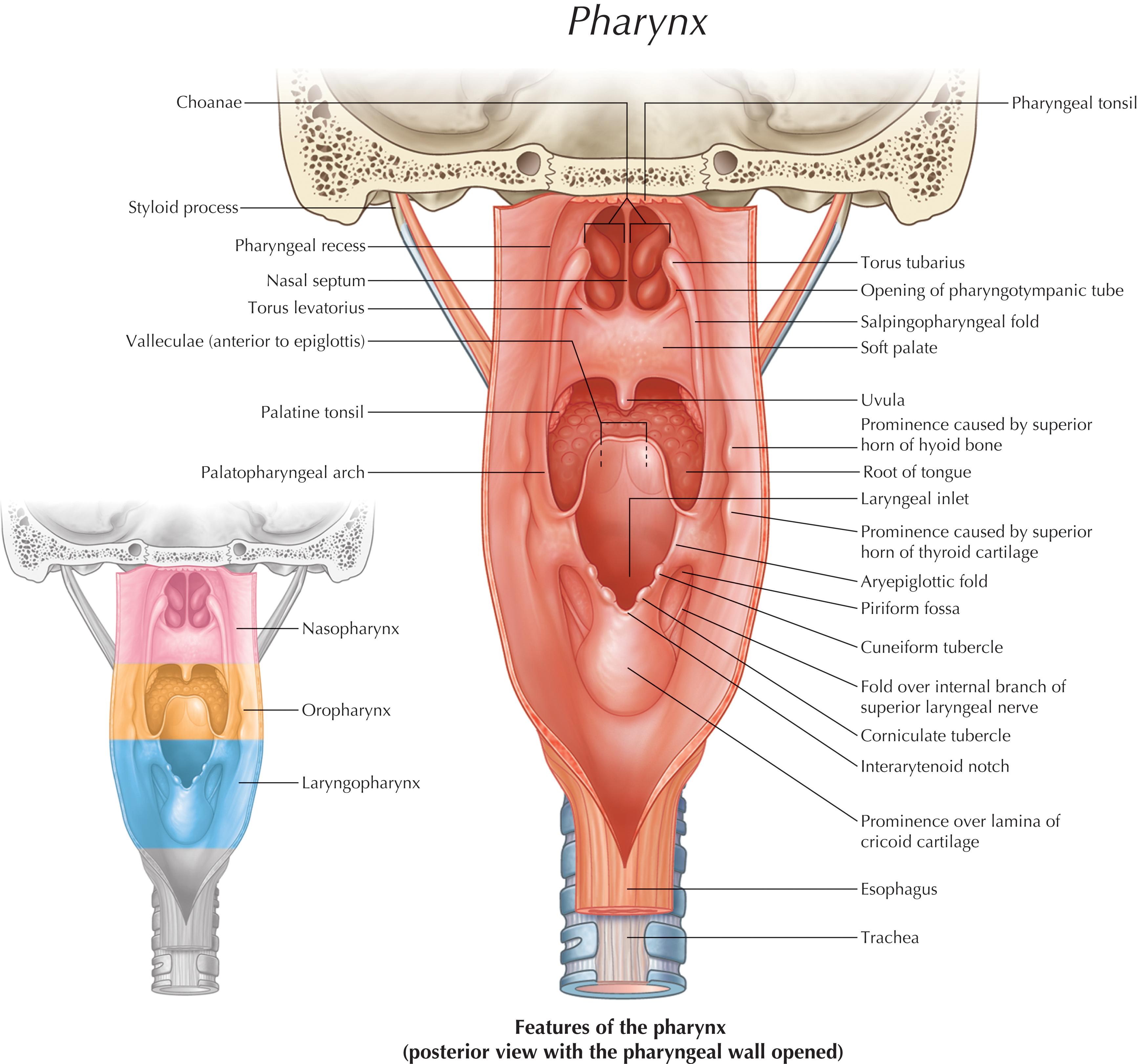
The epiglottis is a spoon-shaped plate of elastic cartilage that lies behind the tongue. It prevents aspiration by covering the glottis—the opening of the larynx—during swallowing. The laryngopharynx/hypopharynx extends from the upper border of the epiglottis to the lower border of the cricoid cartilage. It is separated laterally from the larynx by the arytenoepiglottic folds, which contain the piriform recesses. The piriform sinuses are found at each side of the opening of the larynx, in which the inferior laryngeal nerve lies and swallowed foreign materials may be lodged.
The laryngeal skeleton consists of several cartilages connected by ligaments and muscles: the thyroid, cricoid, epiglottic, and (in pairs) the arytenoid, corniculate, and cuneiform. The larynx serves as a sphincter to prevent the passage of food and drink into the trachea and lungs during swallowing. It also contains the vocal cords and regulates the flow of air to and from the lungs for phonation. It is through the abducted vocal cords of the larynx that an endotracheal tube is advanced during endotracheal intubation ( Fig. 3 ).
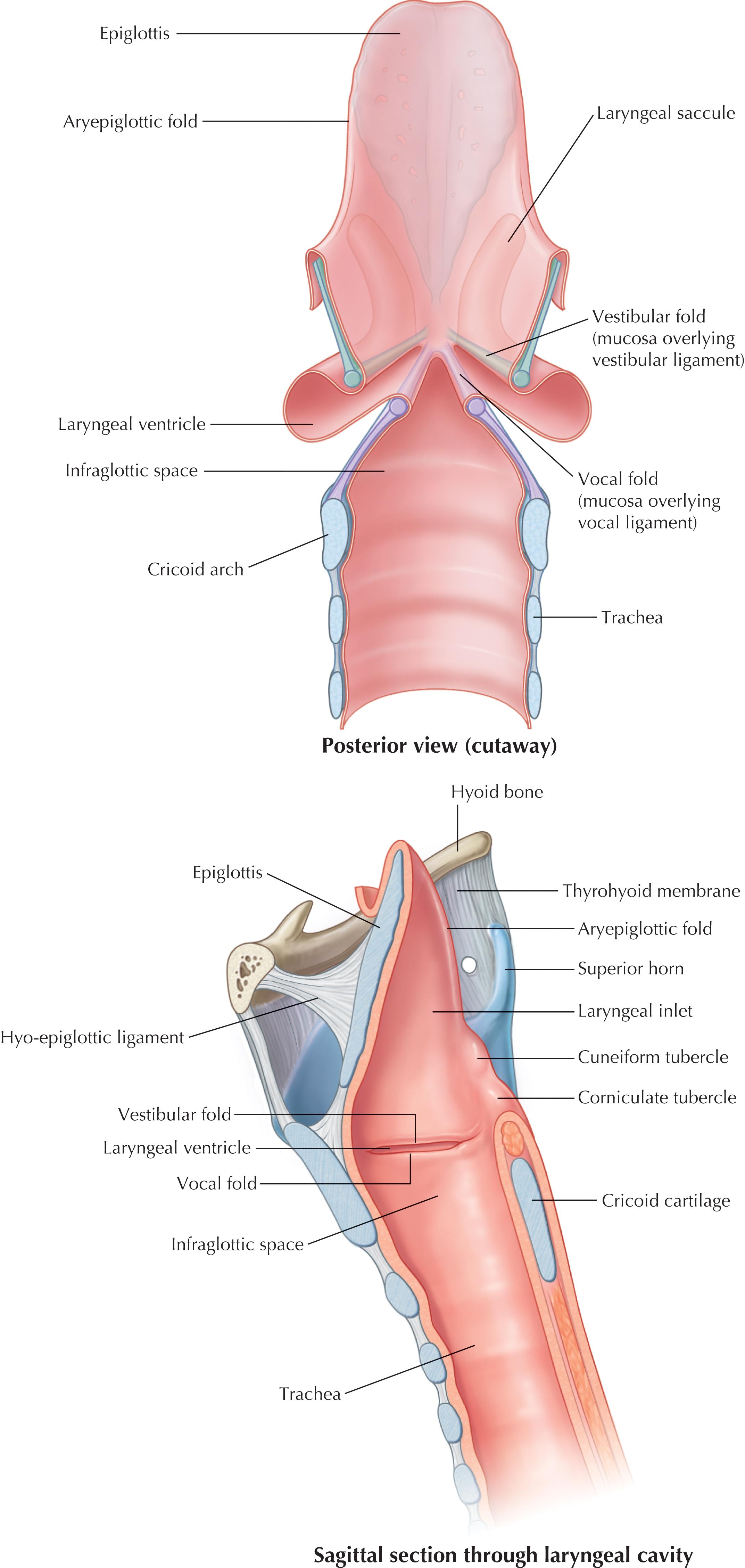
The thyroid cartilage is a large anterior structure that consists of right and left laminae that meet in the midline, forming the thyroid notch and thyroid prominence. The right and left superior projections (horns) of the thyroid cartilage connect to the hyoid bone, and the cricothyroid membrane connects the inferior edge to the cricoid cartilage. This latter anatomic relationship is of particular importance when an emergency surgical airway must be obtained ( Fig. 4 ).
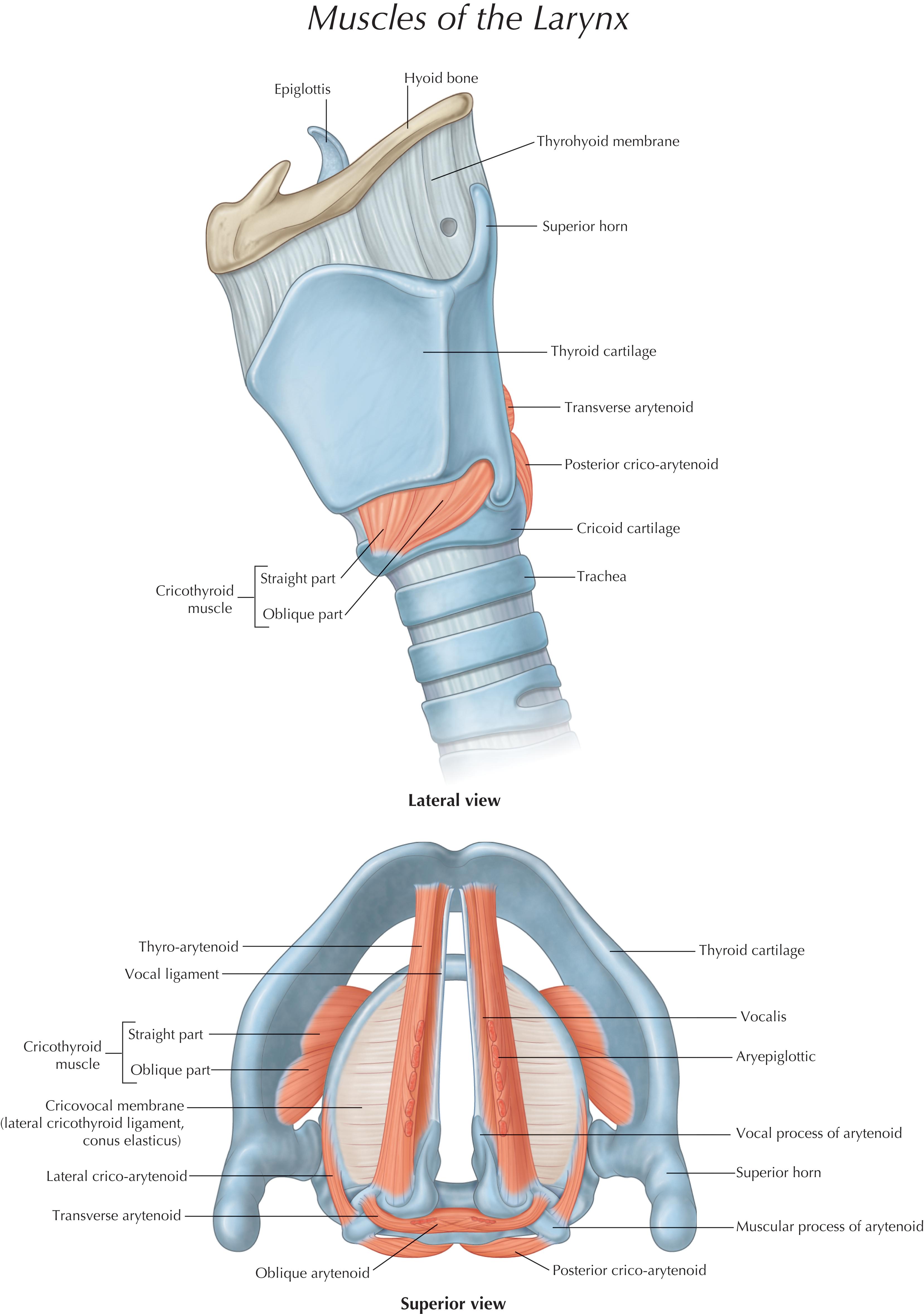
Unlike the thyroid cartilage, which does not project posteriorly, the cricoid cartilage is a complete signet-shaped cartilaginous ring connected to both the thyroid cartilage and the first tracheal ring. This anatomic relationship was used by Sellick, who described the prevention of passive regurgitation of gastric contents by posterior pressure on the cricoid cartilage during the induction of general anesthesia, a technique that has since become the accepted standard of care.
The epiglottis is an elastic cartilaginous structure covered by a mucous membrane. The reflection of this mucous membrane forms a slight depression known as the vallecula. It is at this point that the tip of the laryngoscope blade is placed so as to elevate the epiglottis and visualize the vocal cords. The epiglottis is anteriorly attached, superiorly to the hyoid bone by the hypoepiglottic ligament, and inferiorly to the thyroid cartilage by the thyroepiglottic ligament. The quadrangular ligament extends between the lateral aspects of the arytenoid and epiglottic cartilages. Its free inferior edge is the vestibular ligament and covered with mucosa; it forms the vestibular fold, which lies above the vocal cord (fold) and extends from the thyroid to the arytenoid cartilage. The arytenoids articulate with the superolateral aspect of the cricoid, and each has an anterior vocal cord process that attaches to the vocal cords via the cord ligament. The free superior margin forms the aryepiglottic ligament, and its mucosal covering forms the aryepiglottic fold. It is within the posterior aspects of aryepiglottic folds that the cuneiform and corniculate cartilages can be seen. These cartilages rest on the apex of the arytenoids. Their elastic properties facilitate the return of the arytenoid cartilages to their anatomic position of rest after abduction and can usually be seen during direct laryngoscopy. They can, therefore, be used as a landmark for the tracheal opening when it is difficult to visualize the vocal cords ( Fig. 5 ).
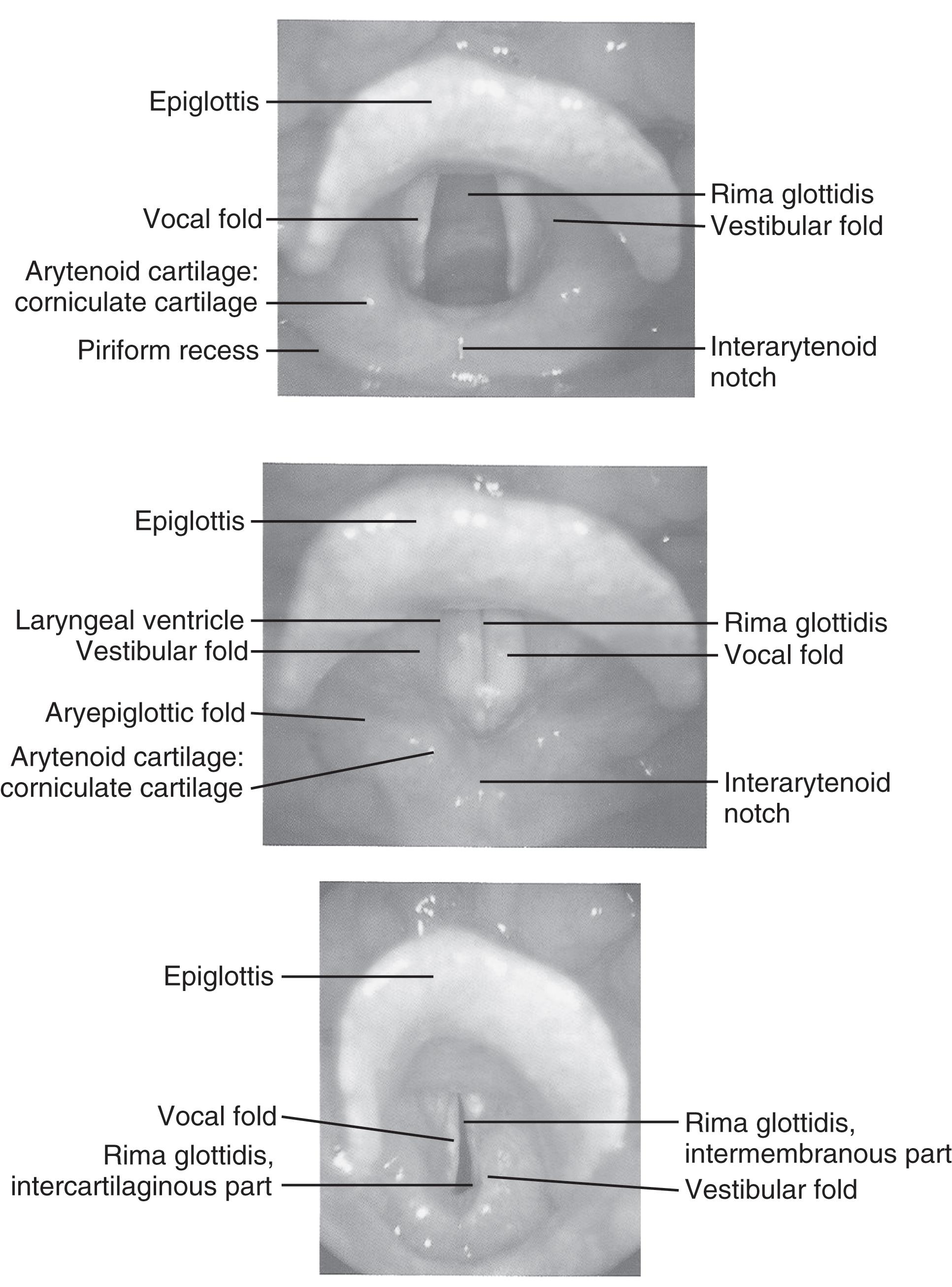
The glottis is contained within the larynx and is the narrowest part of the adult airway. It is composed of the vocal cords (or folds) and the space between them is called the rima glottides. Because the true vocal cords are covered by stratified epithelium, they have the characteristic pearly white color when illuminated. The recurrent laryngeal nerves innervate the cords, and the musculature of the larynx receives its innervation from branches of the vagus nerve (cranial nerve X). The larynx is inclusive of the structures noted previously.
The trachea extends from the inferior border of the cricoid cartilage for a variable distance, dividing into the right and left mainstem bronchi at the carina, which anatomically corresponds to the T4-T5 junction posteriorly and the sternal notch anteriorly. Like the thyroid cartilage, the 16 to 20 tracheal cartilages form incomplete C-shaped rings that open posteriorly, allowing for variability in the tracheal diameter needed for normal airway functional changes. The trachea is in direct apposition posteriorly to the esophagus. This may be of significance in patients who have esophageal tumors or mediastinal hematomas (either traumatic or postoperative in origin) or have ingested large foreign bodies. All of these masses can cause upper (tracheal) airway obstruction.
A thorough but rapid initial assessment of the trauma patient begins with the airway and breathing as first priorities. This step must be done with the understanding that, unless the cervical spine has already been “cleared” clinically, every patient has a cervical spine injury until proved otherwise. Breathing and speech are impossible without an intact airway. Simply asking the patient his name is revealing. Lack of response or change in voice because of a compromised airway is immediately apparent and an indication for adjuncts to secure an airway.
Any patients with a Glasgow Coma Scale (GCS) score of 8 or less, regardless of cause, will need to be intubated to protect and secure the airway. Intoxication and use of illicit substances are frequent causes of an altered mental status, as are closed head injuries and hypoxia. One must, therefore, err on the side of caution and always assume that the depressed GCS score is injury related and that intubation will be needed to protect the airway. Hoarseness, shortness of breath, carbonaceous sputum, or evidence of external burns to the nares and mouth should alert the clinician that an airway may be in jeopardy even if the patient can respond appropriately. These patients must have careful and frequent interval reevaluations, with a low threshold for intubation. In addition, these patients may pose particularly difficult challenges to intubation, and this situation underscores the need for a rapid and careful assessment of each individual airway.
Patient anatomy, both inherent and as altered by injury, is an important factor that requires careful assessment by the clinician prior to attempting definitive airway management. In the trauma patient, the clinician must always be cognizant of the potential for cervical spine injury. This is particularly important in the patient whose physical examination is compromised by an altered mental status, regardless of the cause. The presence of maxillofacial trauma or injuries of the soft tissues of the neck must also be considered when deciding the best way to secure and protect the airway. In the absence of injury or pathologic conditions, the ability to ventilate and control the supraglottic airway is a function of the size of the airway and the compliance of the supralaryngeal tissues. It should be remembered that under normal conditions, airflow through the nasal cavity is not usually a concern in that this portion of the airway is usually supported by rigid elements in its walls. Conversely, the pharynx does not have a rigid support system, and therefore, it is predisposed to collapse. The most common cause of supralaryngeal obstruction is the tongue in obtunded or comatose patients; usually this problem can initially be dealt with effectively with the use of the oral airway.
A more ominous situation arises when the airway is compromised in the immediate vicinity of the laryngeal inlet because of the size of the base of the tongue or the epiglottis. Airflow in this region will be inversely proportional to the size of these structures, as well as the condition of the perilaryngeal tissues. Restriction of airflow to these areas can come from a number of causes; some of the more common causes are trauma to the neck causing anatomic disruption or tissue edema, prior irradiation to the neck, head and neck tumors, and redundant fatty tissue in the perilaryngeal area secondary to obesity. These conditions may lead to the aforementioned “cannot ventilate, cannot intubate” scenario, a potentially fatal situation for even the most skilled airway personnel.
As with any other medical procedure, it is always prudent to perform a methodical evaluation of the situation and determine the preferable approach and equipment needed to perform the task efficiently. In addition to factors previously discussed, one must also assess for scarring and fibrosis to the airway and surrounding tissues; injury to the trachea; congenital anomalies; acute inflammatory or neoplastic diseases of the airway; and, finally, gingival, mandibular, and dental anomalies or disease. Short, muscular individuals with very short necks and obese patients tend to be difficult to intubate. Morbidly obese patients can compromise the airway with excessive redundant tissue in the paratonsillar and paraglottic areas, masking visualization and accessibility of the glottis during laryngoscopy. Anatomic factors that should be assessed include mandibular mobility at the temporomandibular joints; mobility of the head at the atlanto-occipital joint (when cervical spine injury has been ruled out); the length, size, and muscularity of the neck; size and configuration of the palate; the proportionate size of the mandible in relation to the face; and the presence of an overbite of the maxillary teeth. Two rapid assessments of these factors can be useful. A thyromental distance of less than three fingerbreadths has been shown to be associated with more difficult mask ventilation. Also, the Mallampati score used by anesthesiology in elective cases (see Fig. 1 in “Prehospital Airway Management” located in Part II) has also been shown to be a predictor of difficult direct laryngoscopy.
In order to classify a Mallampati score, the patient is asked to open the mouth as widely as possible and protrude the tongue out as far as possible while seated, with the head in the neutral position, something that is nearly impossible to accomplish in the trauma setting. However, a clinician familiar with the Mallampati classification can perform a cursory evaluation of the oropharynx using a tongue blade or laryngoscope, which provides the clinician some idea as to the potential for difficulty in intubation. It will also demonstrate the existence of any evidence of injury to the oropharynx and the presence of foreign bodies, blood, or vomitus.
Because one cannot always rely on the anesthesiologist to secure the airway, all clinicians caring for the trauma patient must have the ability to provide immediate and effective airway protection and ventilation. Clinicians must, therefore, be able to recognize limitations to airway access and must possess techniques to overcome these limitations. Many tools and techniques are available to the anesthesiologist in the elective setting, and although many of them may not be practical in the emergent trauma setting, several can be used, and they will be the focus of the rest of this discussion.
The best airway is the airway that the patient can safely maintain without any external intervention. The Eastern Association for the Surgery of Trauma has cited the need for emergency tracheal intubation in trauma patients with airway obstruction, hypoventilation, severe hypoxia in spite of supplemental oxygen administration, severe cognitive impairment (GCS score < 8), cardiac arrest, and severe hemorrhagic shock. Once it has been decided that the airway is not adequate, or that the patient is unable to protect the airway, then intubation must be accomplished in a rapid, efficient, and safe manner. It is important to remember that all trauma patients must be intubated with one person maintaining in-line cervical immobilization throughout the procedure to protect the possibly injured cervical spine.
As with all other procedures, a successful outcome depends on the operator’s experience and on having immediate access to all of the correct equipment. Most emergency departments have airway carts that contain all of the equipment that will routinely be needed for emergency intubations, as well as specialty carts designed for the “difficult airway.” Although the contents of these carts will vary from institution to institution, they will usually be standardized within each hospital.
Once the decision to intubate has been made, all patients should be preoxygenated with 100% oxygen. The jaw thrust and chin lift can be done without endangering the cervical spine and should be performed in an attempt to open an airway that may be obstructed by the tongue, which tends to fall posteriorly in the obtunded patient. The chin lift is accomplished by placing one’s fingers under the mandible and gently lifting the mandible upward. The thumb of the same hand is used to depress the lower lip and open the mouth. Care must be taken to prevent hyperextension of the neck while performing the chin lift. The jaw thrust can be performed alone or used in conjunction with bag-valve-mask (BVM) ventilation of the obtunded but breathing patient, and the respiratory efforts are assisted with compression of the bag. By grasping both mandibular angles and displacing the mandible forward, one is able to simultaneously open the airway and obtain and maintain an effective seal with the mask during assisted bag-mask ventilation. Although this technique is possible to perform with a single operator, it is most effective with two skilled staff members. Additionally, a third person is still required to maintain in-line cervical spine stabilization.
Oropharyngeal and nasopharyngeal airways ( Fig. 6 ) are useful, but must be inserted with care, and are contraindicated in patients with severe facial trauma with concern for cribriform plate fractures. Although neither one is well tolerated by the awake patient, the nasopharyngeal airway is better tolerated in the semiresponsive patient and is less likely to stimulate gagging and vomiting. They can both be used to help maintain a patent upper airway in the obtunded patient. In the adult, the oral airway is inserted with the convexity facing down initially. It must be placed carefully, so that it does not push the tongue posteriorly but, rather, is seated posterior to the tongue, displacing the tongue anteriorly. In children, the oral airway must always be placed with the convex surface facing cephalad initially to avoid injury to the soft tissues of the mouth and pharynx. It is important to remember that in patients with a persistent (intact) upper airway gag reflex, the insertion of the oral airway can precipitate laryngospasm and bronchospasm, as well as coughing, gagging, vomiting, and ultimately, aspiration.
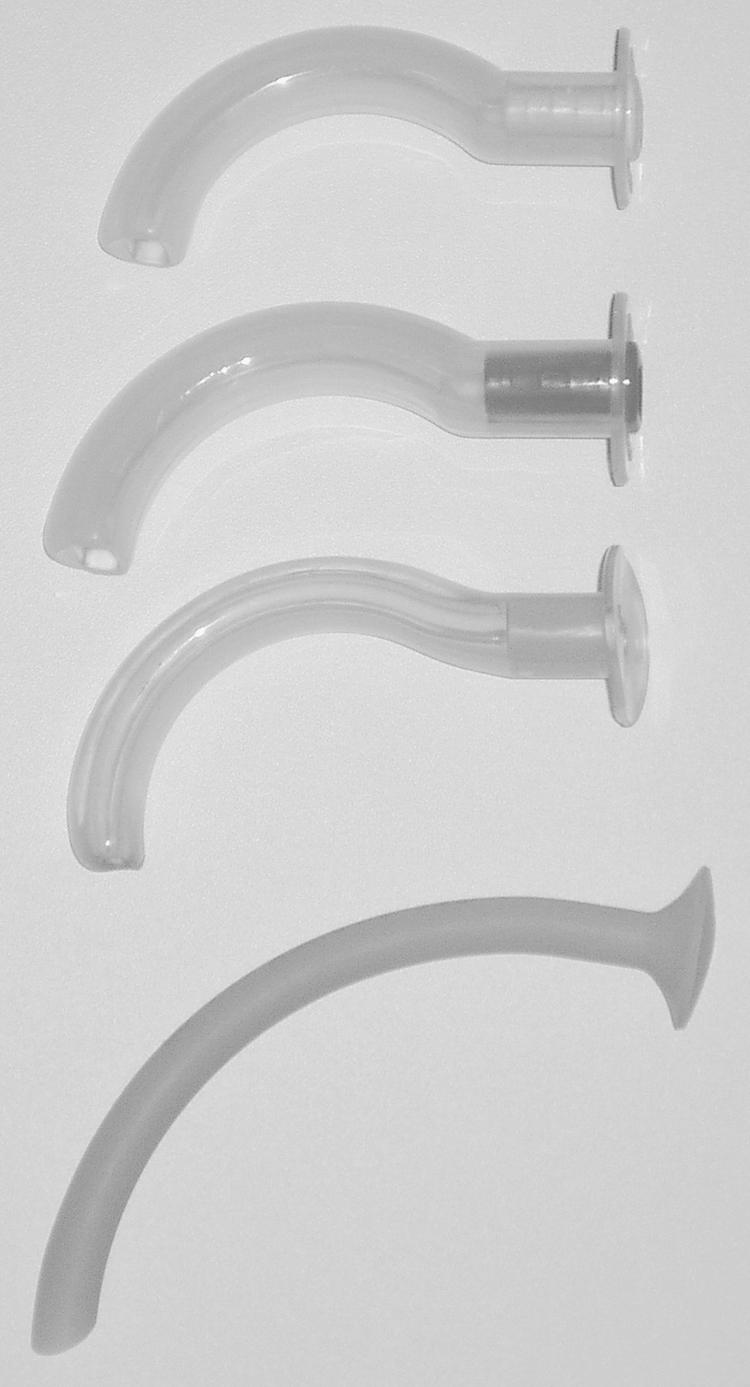
Regardless of technique used to secure the airway, it is imperative that proper tube position is confirmed and documented once a definitive airway has been obtained. The best confirmation of proper tube placement is the direct visualization of the tube passing through the vocal cords during laryngoscopy. Because this is not always the case, tube placement can be rapidly but tentatively confirmed by physical examination. Observation and auscultation of the chest is a valuable clinical tool. In the absence of chest wall disruption due to rib fractures, the clinician will see symmetrical chest wall motion upon ventilation with appropriate tube placement.
Auscultation of the chest is done both anteriorly and in the axillae and is useful when breath sounds are heard bilaterally and are equal. This is not always the case, even with appropriate tube placement, because of the presence of pneumothoraces or hemothoraces seen in the trauma patient population. It is incumbent on the clinician to immediately treat the pneumothorax and hemothorax and then confirm tube thoracostomy placement by both physical examination and chest radiograph. Auscultation over the left upper quadrant of the abdomen is important; with appropriate placement of the endotracheal tube, there will be no gurgling in the stomach during ventilation.
Cyanosis as an indicator of a fall in oxygen concentration is a late event and is influenced by factors such as room lighting, anemia, and hemoglobin anomalies. Resolution of hypoxia is a reliable sign of proper tube placement, but minutes may elapse before a patient shows desaturation by pulse oximetry, especially in patients who have been properly preoxygenated. Identification of carbon dioxide (CO 2 ) in exhaled gas has become the standard for verification of appropriate placement of an endotracheal tube in the elective or emergent setting. This can be accomplished with capnography (the instantaneous display of the CO 2 waveform during ventilation), which is the measurement of CO 2 in the expired gas. Colorimetric CO 2 detectors have become the standard in most institutions due to the ease of use and rapid availability. Colorimetric CO 2 detectors are routinely inserted into the respiratory circuit between the end of the endotracheal tube and the ventilator tubing or Ambu-bag and will detect the presence of CO 2 as soon as ventilation begins after intubation. A change in color signifies the presence of CO 2 in the exhaled gas. It must be remembered that although useful, the presence of CO 2 is not, by itself, absolute assurance of proper tube placement. The endotracheal tube could be improperly positioned in a mainstem bronchus, and one would still detect CO 2 . It is important to remember that CO 2 will not be detected in patients who are in cardiac arrest. In patients who have been actively ventilated prior to intubation, CO 2 can be detected in gas from the stomach when the endotracheal tube is improperly placed in the esophagus. This will clear with several breaths, however, and indicates to the clinician that the tube is improperly placed.
The cuffed portion of the endotracheal tube should be at least 1 to 2 cm below the cords, and in the average patient, the endotracheal tube will be taped in position at the 21- to 23-cm mark at the teeth. Lastly, a chest radiograph should be performed to confirm proper placement of the endotracheal tube after every intubation. The tip of an appropriately placed endotracheal tube should be visible on chest radiograph approximately 5 cm above the carina in the average adult.
Even with all of the equipment and technical advances available to the clinician, clinical judgment, the physical examination, and attention to detail are essential in management of the airway.
The inability to intubate can be a fatal event due to the hypoxia resulting from the inability to ventilate and, therefore, oxygenate the critically ill or injured patient. There are certain “rescue” techniques available, and one such technique involves the use of the dual lumen esophagotracheal tube, known as the Combitube (Tyco Healthcare Group LP, 2001). This tube, which comes in a regular and small adult size, has minimized the problems that had been seen with the use of the esophageal obturator airway as an airway rescue technique. Although Wissler recommends using the laryngoscope for placement of the tube under direct vision, the tube can be inserted blindly through the mouth.
Although the tip of the tube can end up in the trachea, it will enter the esophagus 99% of the time. Once the tube is successfully placed, the balloons are inflated with air, 100 mL in the pharyngeal balloon to occlude the pharynx, and 15 mL in the distal balloon occluding either the esophagus or the trachea. Ventilation is now begun using tube No. 1. If the tip of the tube is positioned in the esophagus (the preferred position), one will hear breath sounds bilaterally, capnography will be positive for CO 2 , and auscultation over the left upper quadrant of the abdomen will be negative for gastric insufflation. At this point, a gastric tube can be placed through tube No. 2 ( Fig. 7 ).
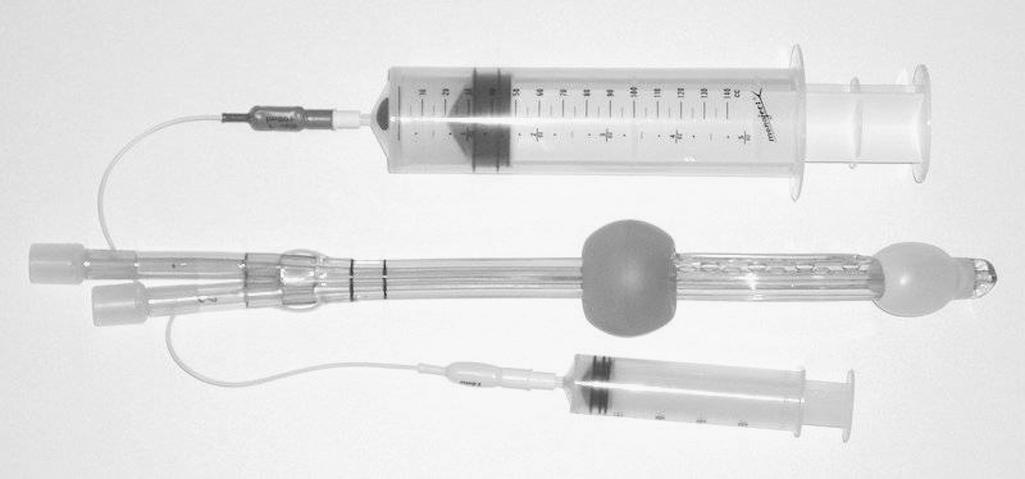
If the tip of the tube is in the trachea, no breath sounds will be heard in the chest, and capnography will be negative for CO 2 . Ventilation should immediately be switched to tube No. 2, and the examination repeated to confirm breath sounds by auscultation and CO 2 by capnography.
The Combitube has been shown to be an effective alternative to prehospital cricothyroidotomy after failed rapid-sequence intubation (RSI) attempts in patients with severe maxillofacial trauma. In fact, Blostein et al. studied 10 such patients who failed in-field intubation. The Combitube was successfully replaced in hospital by an orotracheal tube in 7 of the 10 patients and only 3 required a surgical airway. It must be remembered that the Combitube must be replaced with a definitive airway as soon as the clinical situation permits. Furthermore, it should be remembered that contraindications to use of a Combitube include patients who: (1) are younger than 16 years, (2) are responsive with an intact gag reflex, (3) have known esophageal disease, and (4) have a known ingestion of a caustic substance. Although the Combitube remains an important adjunct to endotracheal intubation in the field, the use of the Combitube in the trauma bay remains limited.
In the adult, the placement of a cuffed tube within the tracheal lumen is considered to be a secure airway. This definitive airway can be achieved nasally, orally, or surgically (cricothyroidotomy or tracheostomy). The level of urgency for airway control and the skill set of the clinician will determine the indication for each of these techniques.
Become a Clinical Tree membership for Full access and enjoy Unlimited articles
If you are a member. Log in here